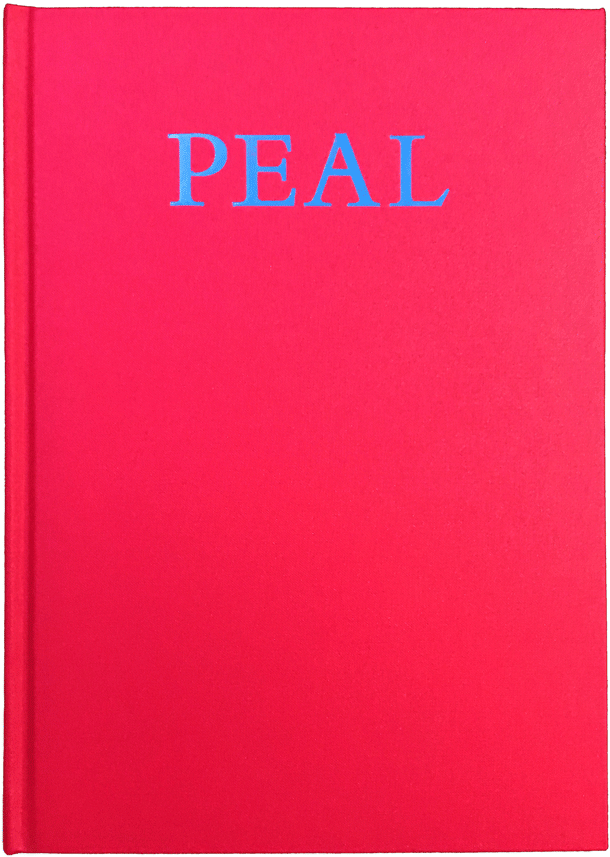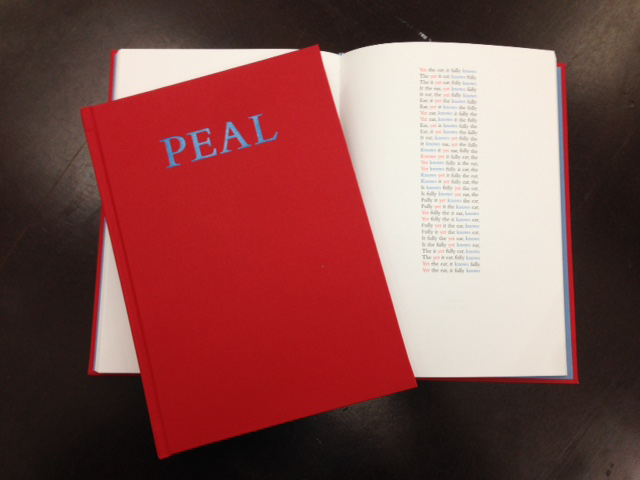|
 |


Most people associate composition using mathematical constraint with avant gardes. Yet for more than four hundred years a tradition of algorithmic composition has flourished in the art of change ringing—the practice used, in the English-speaking world, to sound sets of free-swinging bells in the towers of churches and college chapels. Fixed algorithms or patterns called methods modulate the order of the pealing bells, each with its own musical character and colorful name.
Once the bells are sounding in series, called rows, any given bell can only trade places with an adjacent bell. Within this rigorous constraint, ringers have invented thousands of methods based on selected permutations of the row.
Syntax is to word order as melody is to note order.
Peal explores the analogy of melody and syntax by applying the methods of change ringing to rows of words: poetic lines. The starting lines—all quotations—form the cento that opens the book, where their inflections evoke thematic relationships. Their permutations create distinctive visual patterns as well as frequent semantic surprises. The methods have been chosen with an eye to the associations created by juxtaposing their names with the corresponding starting lines.
|
Purchase PEAL:
|
|
|
|
 |
| About PEAL |
|
Some books you wait half a lifetime for. They arrive almost complete as if they had always existed, and all you can do is realise them. . . . Randall Couch’s Peal is one of them, as were, in their time, Kurt Schwitters’ I Build My Time, 2001 and Cralan Kelder’s Lemon Red, 2005. That is what emanates from Randall Couch’s book, its timelessness. It is almost a medieval book, but one that could only be achieved in the digital age.
Coracle books remain almost clandestine, shelved in our barn in rural Tipperary. They circulate via the occasional book fair, general travel and demonstration, the intermittent website listing, but mostly they see the light through prepared lists for particular libraries. An edition of three hundred copies, as is this one and is often the case for a book of poems, will last about three years. After that, we will struggle to find a copy amongst the boxes of new books, but I have a feeling that Peal will always be with us
in its completeness.
|
—Simon Cutts,
Publisher, Coracle Press |
As an artistic book-object, Peal is well-nigh perfectly conceived. Just as you would expect from Coracle, it is beautifully designed, if a little austere. Ian Hamilton Finlay said towards the end of his life that 'art is a small adjustment,' and very many small adjustments went into what Coracle describes as 'perhaps one of the most elaborate of [their] productions.' Every single parameter and detail of this bright and clangorous book interrelates satisfyingly when examined, like snugly interlocking tesserae. |
—David Briers,
Art Monthly (London) |
Change ringing provides the model for Randall Couch’s remarkable book of poems, Peal. Inspired by what he describes in his book’s introduction as the “rigorous constraint” of change ringing, Couch takes a series of quotations sourced from various fields — canonic and contemporary literature; twentieth-century art, music, and theory; psychology; philosophy; physics; computer science; linguistics; social theory; computer gaming; architecture; and, rather appositely, Stedman and Duckworth’s Tintinnalogia — and permutes them according to the “methods” of change ringing.
By means of this quoted material, Couch explains, “Peal explores the analogy of melody and syntax by applying the methods of change ringing to rows of words: poetic lines.” Thus, true to its title, Peal presents a series of syntactical changes as if rung on a set of bells. The result is thirty-two poems that are preceded by a cento formed out of the same set of quotations. In the spirit of change ringing, these poems explore what Ingram calls “the mystery and wonder of permutations.”
. . . As the titles of a number of poems suggest, chance certainly remains a possibility within the rules and parameters of Peal’s rigorous constraints: “Either,” “Surprise,” “Dice,” and, my favorite, “Chancy.” The aleatory is also evident in “Numbers” where Pope’s quotation, “But most by numbers judge a poet’s song,” invites a number of interpretations due to the indeterminate meaning of “most.” Do we read Pope’s line as further reflection on the mathematics of Peal’s poetics, or as a comment on the unimaginative, formulaic way that poetry is read and valued? Or, perhaps, we might take it as a claim about a poem’s conformity to scansion and meter (what Pound called “the metronome” and compared unfavorably to “the musical phrase”). Here, paradoxically, the certainty of numbers, rules, parameters, and systems makes words, to cite from another of Peal’s poems, as “restless as dice.”
. . . But these underlying tensions that occur between chance and design, happenstance and determinacy, limit and liberty, as well as between harmony and discord, are what make Peal such an engaging, and, one might add, striking book. Charles Ives — composer of The Bells of Yale and From the Steeples and Mountains — claimed that, “An apparent confusion if lived with long enough may become orderly.” The poetic permutations of Peal are resounding affirmations of such a sentiment. |
—Ross Hair,
Jacket2 |
PEAL reviewed
Art Monthly March 2018
Jacket2 April 11, 2018
Philadelphia Inquirer (exhibition) Feb 21, 2018
British Library English and Drama blog May 5, 2023
Elliptical Movements blog May 8, 2024
|
PEAL on exhibition
Writers Making Books (Whitman at 200: Art and Democracy) Arcadia University Spruance Gallery, Jan - April, 2019
|
|
|


